Saltillo, Coahuila 作者: 来源: 发布时间:2021-07-22
1.Basic data
Pop: 1,222,107 (metro)
Area: 272 km2
Elev: 1592 masl
Saltillo location in Mexico within the State of Coahuila
https://goo.gl/maps/eZYWvJxpvKeBarhu9
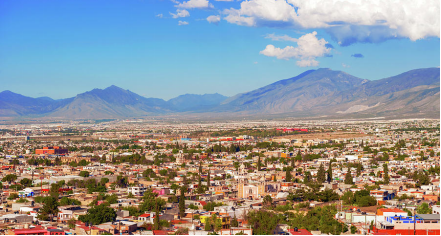
2. Natural geography
Bushes predominate in more than 80%. Towards the northwest, the scrubland mixes with grasslands. To a lesser extent, in the Sierra Madre Oriental and at elevations of volcanic origin there are coniferous and oak forests.
In the aforementioned bushes: tlalcoyote, wild cat, desert fox, kangaroo rat, Cuatro Ciénegas puppy, Lugo lizard-scorpion and prairie dog. In the grasslands: bighorn sheep, red deer, puma and armadillo. In the forest: bat, black bear, shrew and skunk. In the rivers: mojarra and otter. Animals in danger of extinction: pronghorn, American bison, mole, carp, porcupine, quail and coyote.
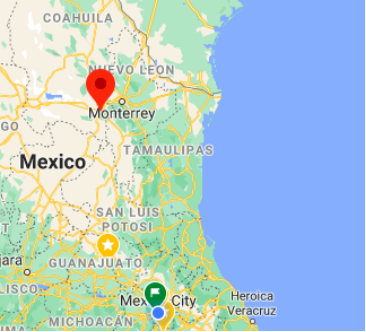
http://cuentame.org.mx/monografias/informacion/coah/territorio/recursos_naturales.aspx?tema=me&e=05#:~:text=En%20matorrales%3A%20tlalcoyote%2C%20gato%20mont%C3%A9s,los%20r%C3%ADos%3A%20mojarra%20y%20nutria
Weather
Köppen Classification: Mid-Latitude Steppe and Desert Climate
This climate type is characterized by extremely variable temperature conditions, with annual means decreasing and annual ranges increasing poleward, and relatively little precipitation. This climate is typically located deep within the interiors of continents and is contiguous with the tropical desert climates of North and South America and of central Asia. This region type owes its origins to locations deep within continental interiors, far from the windward coasts and sources of moist, maritime air. Remoteness from sources of water vapor is enhanced in some regions by mountain barriers upwind.
The Köppen Climate Classification subtype for this climate is "Bsh". (Mid-Latitude Steppe and Desert Climate).
The average temperature for the year in Saltillo is 64.9°F (18.3°C). The warmest month, on average, is June with an average temperature of 73.8°F (23.2°C). The coolest month on average is January, with an average temperature of 53.8°F (12.1°C).
The highest recorded temperature in Saltillo is 104.9°F (40.5°C), which was recorded in June. The lowest recorded temperature in Saltillo is 5.9°F (-14.5°C), which was recorded in January.
The average amount of precipitation for the year in Saltillo is 14.5" (368.3 mm). The month with the most precipitation on average is September with 2.5" (63.5 mm) of precipitation. The month with the least precipitation on average is March with an average of 0.3" (7.6 mm). In terms of liquid precipitation, there are an average of 60.2 days of rain, with the most rain occurring in August with 9.2 days of rain, and the least rain occurring in March with 2.0 days of rain.
Getting there and around
Saltillo Metropolitan Area air traffic is served by Plan de Guadalupe International Airport. It takes 15 minutes to get from downtown Saltillo to the airport. It has several flights per day to Mexico City and but no international flights.
However, we recommend flying to Monterrey (MTY) Airport, which is 97.8 km away from Saltillo. The bus via Monterrey Airport from Monterrey (MTY) to Saltillo takes 4h.
Also, the cheapest way to get from Monterrey to Saltillo is to rideshare which costs $93 and takes 1h 29m.
There is a direct bus departing from Monterrey and other cities, and arriving at Saltillo. Services depart hourly, and operate every day. The journey from Monterrey takes approximately 1h 50m.
https://www.rome2rio.com/s/Monterrey/Saltillo
https://www.rome2rio.com/s/Nearby-Airports/Saltillo
Get around
Downtown Saltillo is best explored using the TranVia trolley system. For M$20 (pesos), you can get on and off 4 times. TranVia does not operate on Mondays.
Taxi - Taxis are a fairly convenient and safe way to get around the city. Be sure to call only verified taxi service. Before you get in a taxi make sure you know the way.
Uber is expanding rapidly across Mexico and now offers services in cities across the country, including: Mexico City, Toluca, Cuernavaca, Puebla, Querétaro, León, Aguascalientes, San Luis Potosí, Guadalajara, Monterrey, Hermosillo, Tijuana, Mexicali, and Mérida. Uber has been adding Mexican cities to its network every year, check for availability when you arrive at your destination in Mexico.
Cabify is developing also and currently operates in cities including Mexico City, Toluca, Monterrey, Puebla, Querétaro and Tijuana. Check for availability in the city you are visiting.
The services offers people with smartphones a way to book a cab through a mobile app for a pre-agreed price. Fares are comparable with Sitio type cabs (see above), and sometimes trade at a premium to this when local demand increases.
https://www.mexperience.com/transport/taxi-travel-in-mexico/#51
3.Economy
GDP: 13,280 M USD
4. Industry
The city of Saltillo is an urban and commercial area, a large part of the population works in the industry that is concentrated in the municipality of Ramos Arizpe, considered one of the most industrialized areas of the country that makes up one of the largest automotive clusters in Mexico Since 1970, plants such as Grupo Industrial Saltillo, General Motors, Magna, Fiat Group, Chrysler, Daimler, Freightliner, Delphi, Nemak, Plastic Omnium, etc. have been installed in the region.
To the south of Saltillo, Coahuila, towards Zacatecas, there are some industrial parks, among them La Angostura and Derramadero, which serve as channels to increase trade and that in a short time have grown by leaps and bounds. Both national and foreign companies are playing a very important role in terms of investment in this area, because these companies have brought their suppliers closer to facilitate logistics processes, with them sources of employment are generated and a better image is created of the region making it attractive for future investments.
https://es.wikipedia.org/wiki/Saltillo
Ciudad Derramadero
Derramadero City, a megaproject that includes a space of 100 hectares with an integral urban development that considers more than 3,400 homes in a first stage, a shopping center, a medical center, green sports and recreation areas.
It is intended that Ciudad Derramadero impact in the short term 17 thousand workers and their families, who come and go every day from Saltillo, Ramos Arizpe and Arteaga to the Derramadero Valley. In addition to the inhabitants who live in the rural communities surrounding this area.
One of the main benefits of this project will be to improve the quality of life of the workers, by reducing by more than 70% the transportation time from their current home to their source of work.
Create decent homes within an urban design that encourages family coexistence, education, recreation and facilitates mobility and promote the vocation of the Derramadero Valley, generating industrial, agricultural and wine-growing development by creating decent and quality housing developments.
Derramadero is a town that is part of Saltillo, and for more than 20 years it has had great growth potential in the region, as it offers a planned development with extensive capabilities for industrial services, thus becoming one of the industrial bastions of the region. southeast of Coahuila.
Currently, Derramadero has six Industrial Parks that are Alianza Derramadero, Parque Industrial Derramadero I and II, FINSA Sur, Santa Fe and Santa Mónica, where around 52 companies operate, five of which have a presence in six countries and have a turnover of around 17,000 million of dollars; The highway that connects with Saltillo is being expanded to speed up daily traffic and the Technological University of Saltillo is also installed, making the industrial offer more attractive.
https://www.mexicoindustry.com/es/news/coahuila/presentan-ciudad-derramadero-un-proyecto-que-beneficiar-a-la-industria
5. Touristic sites
Plaza de Armas
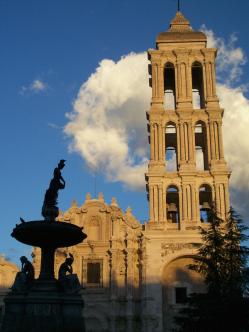
Elsewhere in Mexico, the main plaza is called the zócalo. In northern Mexico, they prefer the term Plaza de Armas. Regardless of what it’s called, every Mexican city’s main plaza is bordered by a church on one side and a government building on another. Saltillo is no exception, and the state government building and the cathedral sandwich a fountain showcasing Victorian-era frolicking nymphs.
Saltillo’s cathedral concentrated all its over-the-top baroque efforts on the outside of the building. On the inside, the decorations are much more subdued than churches further south, making it an authentically peaceful place.
Crossing the Plaza de Armas, the State Palace flaunts its imposing pink façade over the square. Don’t be afraid of the armed guards at the entrance. Walk through the metal detectors and enjoy a series of murals depicting key moments of Mexican history. Across the courtyard is a small, free museum highlighting Saltillo’s role in Mexican history. And, if you drank too much lemonade at Compadres, they have free, clean bathrooms.
Serape Museum
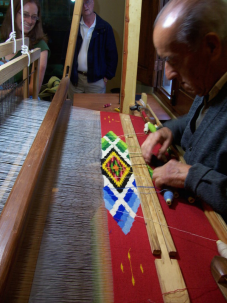
Saltillo’s claim to fame is the serape, that colorful blanket that used to be worn like a poncho and is engraved in most people’s minds as the traditional Mexican costume. Although most Mexicans haven’t worn a serape in over 100 years, Saltillo is still proud of its serape-making heritage. This small, but comprehensive museum showcases the history of the serape, the techniques to make one, complete with a collection of serapes from the colonial era to the present. In the afternoons, an octogenarian weaver works a loom by the entrance, demonstrating his skills. He’s not chatty, but his work is mesmerizing.
To get to the Serape Museum from the Plaza de Armas, walk to the backside of the government palace, and turn left at the stoplight on Allende. It’s half a block up the street, on the right side.
The Desert Museum
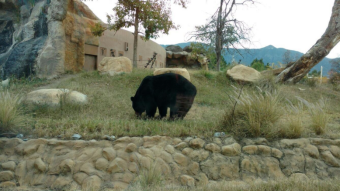
The Desert Museum does its best to pack the essence of the whole region under one roof. The first few rooms are rather scientific, defining what is a desert, as well as the flora and fauna that exists in the Chihuahuan Desert. This state is home to some great dinosaur digs, and they have paleontology labs on display, followed by a gallery of huge dinosaur skeletons.
The second section of the museum explores human history in the state of Coahuila–prehistory through the present age. At the end, they have a collection of reptiles, and outside, prairie dogs frolic, black bears roam (cubs rescued from forest fires), and big-horned sheep graze.
https://pinkpangea.com/2015/03/48-hours-in-saltillo-mexico
6. History and Culture
Several explorers surely crossed the current Saltillo valley in search of mines, although it is known that the main source of wealth was based on the capture of Chichimeca Indians to enslave them or sell them in the mining cities. The first group of explorers on record arrived in Coahuila at the end of 1568, commanded by Francisco Cano, Deputy Mayor of Mazapil, who explored the south of the current municipalities of Saltillo and General Cepeda, taking possession on behalf of Nueva Galicia. . The following year, Martín López de Ibarra, Lieutenant Governor of Nueva Vizcaya, explored the same area and distributed grants and lands in the name of his province. Captain Francisco de Puga and Luis de Carvajal probably also entered around 1573. Later, the Portuguese Alberto del Canto, who had been a neighbor of the Real de Mazapil, carried out the foundation of the town of Santiago del Saltillo, on behalf of the Government of Nueva Vizcaya, shortly before 1577.
Saltillo is the oldest post-conquest settlement in Northern Mexico. In 1591, the Spanish resettled a community of their Tlaxcaltec allies in a separate nearby village, San Esteban de Nueva Tlaxcala. The Spanish did this in order to cultivate the land and to aid stalled colonization efforts. Saltillo grew slowly due to hostility from the indigenous Chichimeca people and water shortages, and a 100 years after its founding its population was only about 300. In comparison, the population of the adjoining Tlaxcalan town at the time, San Esteban, was about 1,750.
In the eighteenth century, Saltillo was a commercial center on the northern frontier which served as a bridge from central Mexico to regions further northeast such as Nuevo León, Nuevo Santander, Coahuila, and Texas. It also supplied the silver mines of Zacatecas with wheat. It never rose to great prominence, but did develop a commercial core and an agricultural and ranching sector that supplied its needs, with surpluses that could be sold. Saltillo became administratively important at the end of the eighteenth century, when a branch of the Royal Treasury was established in the city. Merchants, most of whom were Iberian Peninsula-born Spaniards, constituted the most important economic group, handling a wide variety of goods and selling in shops. They were the provincial branch of the transatlantic merchant sector, with ties to Mexico City merchants. Peninsular merchants in Saltillo married into the local elite society, acquired rural properties, and sought local office. In the late seventeenth century, an annual trade fair was established, which carried Mexican livestock and manufactured goods to places as far as China and Europe. Saltillo could produce wheat commercially as long as there was access to water, but as with many other parts of the North, drought was a consistent threat. In the eighteenth century, there was a demand for draft animals, which Saltillo supplied.
In 1824, Saltillo was made the capital of the State of Coahuila y Tejas which included the area of the current U.S. state of Texas until the Texas War of Independence and the founding of the independent Texas Republic. On 23 October 1840, the Battle of Saltillo took place after 110 Texans and Tejanos crossed the Rio Grande and attacked the city as part of a campaign to establish the Republic of the Rio Grande, a separatist rebellion in northeastern Mexico which had Texan support.
The city of Saltillo has had some other important episodes in the history of Mexico. One of the most prominent was the one that occurred on February 22, 1847 during the Mexico-United States war: the battle of La Angostura, in which Mexican troops and North American invaders participated, the first commanded by López de Santa Anna and General Mora , Villamil, Micheltorena, Blanco, Corona, Pacheco, Lombardini, Urrea, Sánchez and others; and the second, commanded by General Zachary Taylor. There were bloody clashes between the fourteen thousand Mexicans and the seven thousand invaders who had superior artillery. The Mexicans triumphed on various fronts without obtaining victory since, inexplicably, they withdrew from the battlefield.
Porfiriato and Mexican Revolution
Modernity reached Coahuila with the arrival of the railroad in 1880, during the Porfiriato. In 1890, telegraph, telephone, and street lighting networks were created in addition to the construction of cultural buildings, including theaters and plazas, and buildings of a social nature such as hospices, civil hospitals, and sanitary structures consisting of drinking water and drainage systems.
During the Mexican Revolution, several characters from Coahuila had relevancy, who had studied in Saltillo schools such as the Ateneo Fuente and the Colegio de San Juan, among others.
During the Mexican Revolution, Saltillo was taken in separate events by the forces of Victoriano Huerta, Francisco Villa, and then by those of Venustiano Carranza. Hundreds of peasants were forced to join these various groups. As a result, many fled to Texas, including aristocratic families.
20th century
In 1923 the Antonio Narro Agrarian University was founded. Two decades later in 1943, the Monterrey Institute of Technology and Higher Education was established in the city, then in 1951, the Technological Institute of Saltillo and in 1957, the Autonomous University of Coahuila was established.
Saltillo's agricultural climate in the second half of the 20th century was rapidly transforming into industrial activity; huge orchards disappeared and factories began to dominate the landscape.
In the second quarter of the twentieth century, Saltillo changed from agricultural and textile activities towards industrial activities, with the creation of companies such as CIFUNSA, CINSA, Éxito, and Molinos el Fénix, among others.
The true industrial explosion occurred in the '70s and '80s with the arrival of the car industry to the region. Companies such as General Motors and Chrysler, along with their respective satellite companies or suppliers, came to Saltillo. Since then, Saltillo and its Metropolitan Zone (Ramos Arizpe and Arteaga) are known as the "Detroit of Mexico". However, a movement is currently underway to diversify the industry, with the arrival of pharmaceutical companies, household appliances, chemicals, ceramics, and even parts for the aerospace industry.
XXI century
Saltillo is located in a penisismic zone, where several earthquakes or telluric movements have been registered. The last one was registered in May 2018 with magnitude 4.0 on the Richter scale.
In Saltillo, the first union between two people of the same sex took place in all of Latin America. This happened in January 2007 when two women from Matamoros, Tamaulipas, joined together through the Civil Solidarity Pact.
7.Contact Information
City Mayor: Manolo Jiménez Salinas

Contact number: +52 (844) 438 2604, 2605 y 2606
Govt. Office Address: Blvrd. Francisco Coss 745, Zona Centro, 25000 Saltillo, Coah.
Twitter: https://twitter.com/manolojim
FB: https://www.facebook.com/Manolo.Jimenez.Salinas
Website: https://saltillo.gob.mx
E-mail: manolojimenez@saltillo.gob.mx
